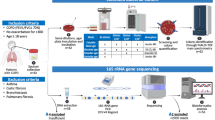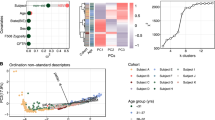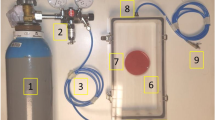Abstract
Chronic bacterial lung infections associated with non-cystic fibrosis bronchiectasis represent a substantial and growing health-care burden. Where Pseudomonas aeruginosa is the numerically dominant species within these infections, prognosis is significantly worse. However, in many individuals, Haemophilus influenzae predominates, a scenario associated with less severe disease. The mechanisms that determine which pathogen is most abundant are not known. We hypothesised that the distribution of H. influenzae and P. aeruginosa would be consistent with strong interspecific competition effects. Further, we hypothesised that where P. aeruginosa is predominant, it is associated with a distinct ‘accessory microbiota’ that reflects a significant interaction between this pathogen and the wider bacterial community. To test these hypotheses, we analysed 16S rRNA gene pyrosequencing data generated previously from 60 adult bronchiectasis patients, whose airway microbiota was dominated by either P. aeruginosa or H. influenzae. The relative abundances of the two dominant species in their respective groups were not significantly different, and when present in the opposite pathogen group the two species were found to be in very low abundance, if at all. These findings are consistent with strong competition effects, moving towards competitive exclusion. Ordination analysis indicated that the distribution of the core microbiota associated with each pathogen, readjusted after removal of the dominant species, was significantly divergent (analysis of similarity (ANOSIM), R=0.07, P=0.019). Taken together, these findings suggest that both interspecific competition and also direct and/or indirect interactions between the predominant species and the wider bacterial community may contribute to the predominance of P. aeruginosa in a subset of bronchiectasis lung infections.
Similar content being viewed by others
Log in or create a free account to read this content
Gain free access to this article, as well as selected content from this journal and more on nature.com
or
Accession codes
References
Anwar GA, McDonnell MJ, Worthy SA, Bourke SC, Afolabi G, Lordan J et al. (2013). Phenotyping adults with non-cystic fibrosis bronchiectasis: a prospective observational cohort study. Respir Med 107: 1001–1007.
Bakkal S, Robinson SM, Ordonez CL, Waltz DA, Riley MA . (2010). Role of bacteriocins in mediating interactions of bacterial isolates taken from cystic fibrosis patients. Microbiology 156: 2058–5067.
Barker AF . (2002). Bronchiectasis. N Engl J Med 246: 1383–1393.
Bergamini G, Di Silvestre D, Mauri P, Cigana C, Bragonzi A, De Palma A et al. (2012). MudPIT analysis of released proteins in Pseudomonas aeruginosa laboratory and clinical strains in relation to pro-inflammatory effects. Integr Biol (Camb) 4: 270–279.
Brook I . (2008). The role of anaerobic bacteria in chronic suppurative otitis media in children: implications for medical therapy. Anaerobe 14: 297–300.
Cohen M, Sahn SA . (1999). Bronchiectasis in systematic diseases. Chest 116: 1063–1074.
Ellis DA, Thornley PE, Wightman AJ, Walker M, Chalmers J, Crofton JW . (1981). Present outlook in bronchiectasis: clinical and social study and review of factors influencing prognosis. Thorax 36: 659–664.
Evans SA, Turner SM, Bosch BJ, Hardy CC, Woodhead MA . (1996). Lung function in bronciectasis: the influence of Pseudomonas aeruginosa. Eur Respir J 9: 1601–1604.
Field TR, Sibley CD, Parkins MD, Rabin HR, Surette MG . (2010). The genus Prevotella in cystic fibrosis airways. Anaerobe 16: 337–344.
Ho PL, Chan KN, Ip MS, Lam WK, Ho CS, Yuen KY, Tsang KW . (1998). The effect of Pseudomonas aeruginosa infection on clinical parameters in steady-state bronchiectasis. Chest 114: 1594–1598.
Joish VN, Splisbury-Cantalupo M, Operschall E, Luong B, Boklage S . (2013). Economic burden of non-cystic fibrosis bronchiectasis in the first year after diagnosis from a US health plan perspective. Appl Health Econ Health Policy 3: 299–304.
Kozlowska J, Rivett DW, Vermeer LS, Carroll MP, Bruce KD, Mason AJ, Rogers GB . (2013). A relationship between Pseudomonal growth behaviour and cystic fibrosis patient lung function identified in a metabolomic investigation. Metabolomics 9: 1262–1273.
Langereis JD, Hermans PW . (2013). Novel concepts in nontypeable Haemophilus influenzae biofilm formation. FEMS Microbiol Lett 346: 81–89.
Lopez AD, Mathers CD, Ezzati M, Jamison DT, Murray CJL . (2006) Global Burden of Disease and Risk Factors. Oxford University Press: USA.
Ma L, Wang S, Wang D, Parsek MR, Wozniak DJ . (2012). The roles of biofilm matrix polysaccharide Psl in mucoid Pseudomonas aeruginosa biofilms. FEMS Immunol Med Microbiol 65: 377–380.
Martínez-García MA, Soler-Cataluña JJ, Perpiñá-Tordera M, Román-Sánchez P, Soriano J . (2007). Factors associated with lung function decline in adult patients with stable non-cystic fibrosis bronchiectasis. Chest 132: 1565–1572.
Nelson A, De Soyza A, Perry JD, Sutcliffe IC, Cummings SP . (2013). Polymicrobial challenges to Koch's postulates: ecological lessons from the bacterial vaginosis and cystic fibrosis microbiomes. Innate Immun 18: 774–783.
Rogers GB, Carroll MP, Serisier DJ, Hockey PM, Jones G, Bruce KD . (2004). Characterization of bacterial community diversity in cystic fibrosis lung infections by use of 16S ribosomal DNA terminal restriction fragment length polymorphism profiling. J Clin Microbiol 42: 5176–5183.
Rogers GB, Cuthbertson L, Hoffman LR, Wing PAC, Pope C, Hooftman DAP et al. (2013c). Towards unbiased bacterial community analysis in lower respiratory infections. ISME J 7: 697–706.
Rogers GB, Hart CA, Mason JR, Hughes M, Walshaw MJ, Bruce KD . (2003). Bacterial diversity in cases of lung infection in cystic fibrosis patients: 16S ribosomal DNA (rDNA) length heterogeneity PCR and 16S rDNA terminal restriction fragment length polymorphism profiling. J Clin Microbiol 41: 3548–3558.
Rogers GB, Hoffman LR, Carroll MP, Bruce KD . (2013a). Interpreting infective microbiota: the importance of an ecological perspective. Trends Microbiol 21: 271–276.
Rogers GB, van der Gast CJ, Cuthbertson L, Thomson SK, Bruce KD, Martin ML, Serisier DJ . (2013b). Clinical measures of disease in adult non-CF bronchiectasis correlate with airway microbiota composition. Thorax 68: 731–737.
Rogers GB, Zain NMM, Bruce KD, Burr LD, Chen AC, Rivett DW et al. (2014). A novel microbiota stratification system predicts future exacerbations in bronchiectasis. Ann Am Thorac Soc 11: 496–503.
Sadikot RT, Blackwell TS, Christman JW, Prince AS . (2005). Pathogen-host interactions in Pseudomonas aeruginosa pneumonia. Am J Respir Crit Care Med 171: 1209–1223.
Schobert M, Jahn D . (2010). Anaerobic physiology of Pseudomonas aeruginosa in the cystic fibrosis lung. Int J Med Microbiol 300: 549–556.
Seitz AE, Olivier KN, Steiner CA, Montes de Oca R, Holland SM, Prevots DR . (2010). Trends and burden of bronchiectasis-associated hospitalizations in the United States, 1993-2006. Chest 138: 944–949.
Serisier DJ . (2012). Inhaled antibiotics for lower respiratory tract infection—focus on ciprofloxacin. Drugs Today 48: 339–351.
Serisier DJ . (2013). Risks of population antimicrobial resistance with chronic macrolide use for inflammatory airways dieases. Lancet Respir Med 1: 262–274.
Serisier DJ, Bilton D, De Soyza A, Thompson PJ, Kolbe J, Greville HW et al. (2013a). Inhaled, dual-release liposomal ciprofloxacin in non-cystic fibrosis bronchiectasis (ORBIT-2): a randomised, double-blind, placebo-controlled trial. Thorax 68: 812–817.
Serisier DJ, Martin ML . (2011). Long-term, low-dose erythromycin in bronchiectasis subjects with frequent infective exacerbations. Respir Med 105: 946–949.
Serisier DJ, Martin ML, McGuckin MA, Lourie R, Chen AC, Brain B et al. (2013b). Effect of long-term, low-dose erythromycin on pulmonary exacerbations among patients with non-cystic fibrosis bronchiectasis: the BLESS randomized controlled trial. JAMA 309: 1260–1267.
Shoemark A, Ozerovitch L, Wilson R . (2007). Aetiology in adult patients with bronchiectasis. Respir Med 101: 1163–1170.
Stressmann FA, Rogers GB, van der Gast CJ, Marsh P, Vermeer LS, Carroll MP et al. (2012). Long-term cultivation-independent microbial diversity analysis demonstrates that bacterial communities infecting the adult cystic fibrosis lung show stability and resilience. Thorax 67: 867–873.
Su S, Hassett DJ . (2012). Anaerobic Pseudomonas aeruginosa and other obligately anaerobic bacterial biofilms growing in the thick airway mucus of chronically infected cystic fibrosis patients: an emerging paradigm or ‘Old Hat’? Expert Opin Ther Targets 16: 859–873.
Tashiro Y, Yawata Y, Toyofuku M, Uchiyama H, Nomura N . (2013). Interspecies interaction between Pseudomonas aeruginosa and other microorganisms. Microbes Environ 28: 13–24.
Tunney MM, Einarsson GG, Wei L, Drain M, Klem ER, Cardwell C et al. (2013). Lung microbiota and bacterial abundance in patients with bronchiectasis when clinically stable and during exacerbation. Am J Respir Crit Care Med 187: 1118–1126.
Tunney MM, Field TR, Moriarty TF, Patrick S, Doering G, Muhlebach MS et al. (2008). Detection of anaerobic bacteria in high numbers in sputum from patients with cystic fibrosis. Am J Respir Crit Care Med 177: 995–1001.
van der Gast CJ, Cuthbertson L, Rogers GB, Pope C, Marsh RL, Redding GJ et al. (2014). Three clinically distinct chronic pediatric airway infections share a common core microbiota. Ann Am Thorac Soc Online early doi:10.1513/AnnalsATS.201312-456OC.
van der Gast CJ, Walker AW, Stressmann FA, Rogers GB, Scott P, Daniels TW et al. (2011). Partitioning core and satellite taxa from within cystic fibrosis lung bacterial communities. ISME J 5: 780–791.
Visser S ., Martin ML, Serisier DJ . (2012). Improvements in cystic fibrosis lung disease and airway inflammation associated with etanercept therapy for cystic fibrosis: a case report. Lung 190: 579–581.
Weycker D, Edelsberg J, Oster G, Tino G . (2005). Prevalence and economic burden of bronchiectasis. Clin Pulm Med 12: 205–209.
Acknowledgements
This study was supported by the Mater Adult Respiratory Research Trust Fund.
Author information
Authors and Affiliations
Corresponding author
Ethics declarations
Competing interests
The authors declare no conflict of interest.
Additional information
Supplementary Information accompanies this paper on The ISME Journal website
Supplementary information
Rights and permissions
About this article
Cite this article
Rogers, G., van der Gast, C. & Serisier, D. Predominant pathogen competition and core microbiota divergence in chronic airway infection. ISME J 9, 217–225 (2015). https://doi.org/10.1038/ismej.2014.124
Received:
Revised:
Accepted:
Published:
Issue date:
DOI: https://doi.org/10.1038/ismej.2014.124
This article is cited by
-
Understanding the effects of Haemophilus influenzae colonization on bronchiectasis: a retrospective cohort study
BMC Pulmonary Medicine (2024)
-
Landscape Seroprevalence of Three Hemorrhagic Disease-Causing Viruses in a Wild Cervid
EcoHealth (2021)
-
A longitudinal characterization of the Non-Cystic Fibrosis Bronchiectasis airway microbiome
Scientific Reports (2019)
-
Population dynamics and transcriptomic responses of Pseudomonas aeruginosa in a complex laboratory microbial community
npj Biofilms and Microbiomes (2019)
-
The involvement of McpB chemoreceptor from Pseudomonas aeruginosa PAO1 in virulence
Scientific Reports (2019)



